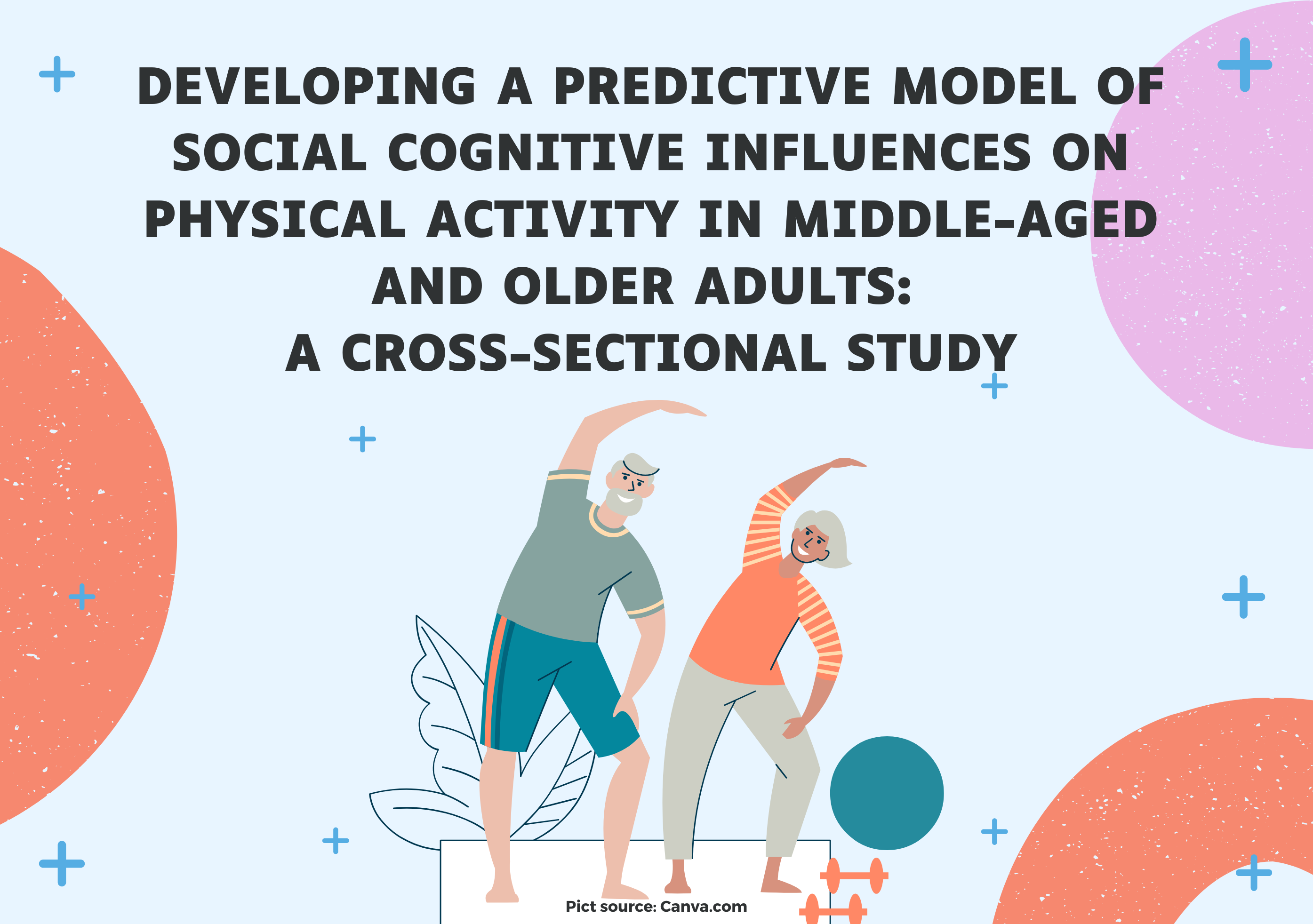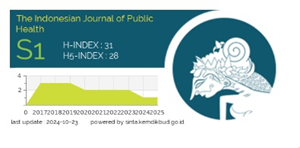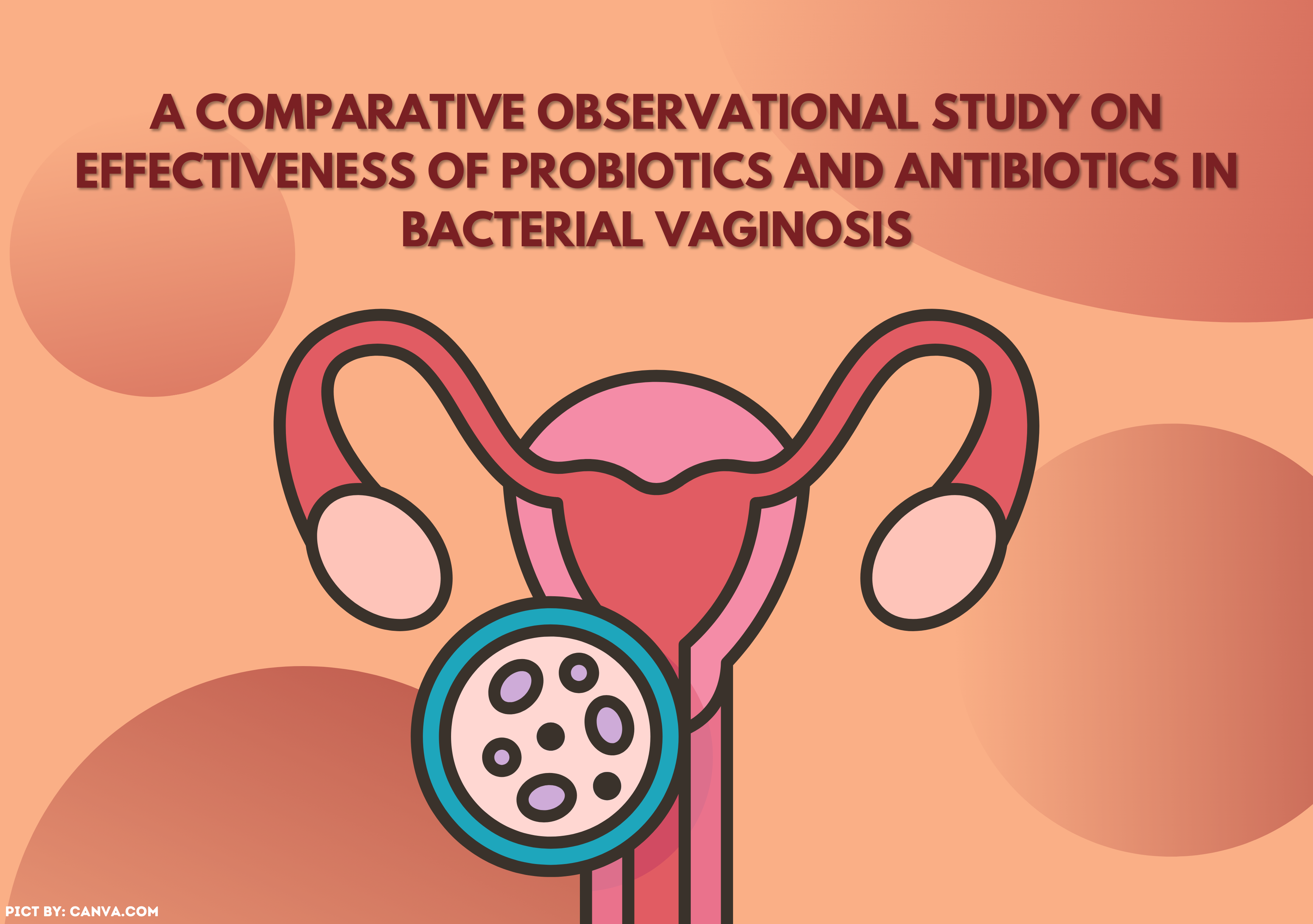DEVELOPING A PREDICTIVE MODEL OF SOCIAL COGNITIVE INFLUENCES ON PHYSICAL ACTIVITY IN MIDDLE-AGED AND OLDER ADULTS: A CROSS-SECTIONAL STUDY

Downloads
Introduction: Increasing physical activity levels in middle-aged and older adults is a critical public health agenda, as regular physical activity reduces morbidity, healthcare costs, and chronic disease risks by up to 90%. Developing effective physical activity programs, however, requires comprehension of factors influencing physical activity behavior. Aims: This research aimed to develop a predictive model of social cognitive influences on moderate and vigorous physical activity (MVPA) in this demographic. Method: A cross-sectional study was conducted in 118 participants, 76% of whom were female. Social cognitive factors, which included self-efficacy, outcome expectations (physical, social, and self-evaluation), self-regulation (goal setting and planning), and social support (from family and friends) regarding physical activity, were assessed using validated self-reported questionnaires. A 7-day Physical Activity Recall interview was conducted to measure MVPA. Data were analyzed using bivariate correlations and stepwise multiple linear regressions, adjusted for sex and age. Results: All social cognitive measures showed moderate to strong correlations with MVPA (r = 0.43-0.79). The regression model, which included self-efficacy, physical outcome expectations, planning, and social support, explained 77% of the variance in MVPA. Conclusion: These results highlight the importance of strengthening these social cognitive factors to encourage more physically activity among middle-aged and older adults in Indonesia.
Alonso, S.L. (2020). Self-efficacy for physical activity of people over 65. Revista INFAD de Psicología. International Journal of Developmental and Educational Psychology, 1(2), 47-56. https://doi.org/10.17060/ijodaep.2020.n2.v1.1979
Anderson, E., & Durstine, J.L. (2019). Physical activity, exercise, and chronic diseases: A brief review. Sports Medicine and Health Science, 1(1), 3-10.https://doi.org/10.1016/j.smhs.2019.08.006
Arovah, N.I. (2022). The correlates of physical activity during COVID-19 pandemic among Indonesian young adults: A longitudinal study. Journal of Education and Health Promotion, 11(1), 179. https://doi.org/10.4103/jehp.jehp_720_21
Arovah, N.I., & Heesch, K.C. (2022). Social cognitive measures related to exercise behaviour: Validation in Indonesian middle-aged and older adults. Clinical Epidemiology and Global Health, 14, 100975 https://doi.org/10.1016/j.cegh.2022.100975
Arovah, N.I., & Kushartanti, B.M.W. (2019). Moderate-vigorous physical activity and clinical parameters in adults with type 2 diabetes mellitus. Romanian Journal of Diabetes Nutrition and Metabolic Diseases, 26(2), 107-117.https://doi.org/10.2478/rjdnmd-2019-0012
Arovah, N.I., Kushartanti, B.M.W., Washington, T.L., & Heesch, K.C. (2018). Walking with diabetes (WW-DIAB) programme a walking programme for Indonesian type 2 diabetes mellitus patients: a pilot randomised controlled trial. SAGE Open Medicine, 6, 2050312118814391. https://doi.org/10.1177/2050312118814
Bandura, A. (2013). Health promotion from the perspective of social cognitive theory. In C. Abraham, P.Norman & M. Conner (Eds.), Understanding and Changing Health Behaviour (pp. 299-339). Psychology Press.
Basrowi, R.W., Rahayu, E.M.,Khoe, L.C.,Wasito, E., & Sundja, T. (2021a). The Road to Healthy Ageing: What Has Indonesia Achieved So Far? Nutrients, 13(10), 3441. https://doi.org/10.3390/nu13103441
Basrowi, R.W., Rahayu, E.M.,Khoe, L.C.,Wasito, E., & Sundja, T. (2021b). The Road to Healthy Ageing: What Has Indonesia Achieved So Far? Nutrients, 13(10), 658-679. https://doi.org/10.3390/nu13103441
Buchman, A. S., Wilson, R. S., Yu, L., James, B. D., Boyle, P. A., & Bennett, D. A. (2014).. Total daily activity declines more rapidly with increasing age in older adults. Archives of Gerontology and Geriatrics, 58(1), 74-79. https://doi.org/10.1016/j.archger.2013.08.001
Cunningham, C., R, O.S., Caserotti, P., & Tully, M.A. (2020). Consequences of physical inactivity in older adults: A systematic review of reviews and meta-analyses. Scandinavian Journal of Medicine & Science in Sports, 30(5), 816-827. https://doi.org/10.1111/sms.13616
Eckstrom, E., Neukam, S., Kalin, L., & Wright, J. (2020). Physical Activity and Healthy Aging. Clinics in Geriatric Medicine, 36(4), 671-683. https://doi.org/10.1016/j.cger.2020.06.009
Garland, M., Wilbur, J., Fogg, L., Halloway, S., Braun, L., & Miller, A. (2021).Self-Efficacy, Outcome Expectations, Group Social Support, and Adherence to Physical Activity in African American Women. Nursing Research, 70(4), 239-247. https://doi.org/10.1097/NNR.0000000000000516
Gellert, P., Ziegelmann, J.P., & Schwarzer, R. (2012). Affective and health-related outcome expectancies for physical activity in older adults. Psychology & Health, 27(7), 816-828. https://doi.org/10.1080/08870446.2011.607236
Gu, D., Andreev, K., & Dupre, M.E. (2021). Major Trends in Population Growth Around the World. China CDC Weekly, 3(28), 604-613.https://doi.org/10.46234/ccdcw2021.160
Hajek, A., & Konig, H.H. (2018). The Association Between Self-Regulation and Daily Sports Activities in a Nationally Representative Sample of Older Adults. Findings From the German Ageing Survey. Frontiers in Physiology, 9, 1763. https://doi.org/10.3389/fphys.2018.01763
Harada, K. (2022). Effectiveness, Moderators and Mediators of Self-regulation Intervention on Older Adults' Exercise Behavior: a Randomized, Controlled Crossover Trial. International Journal of Behavioral Medicine, 29(5), 659-675.https://doi.org/10.1007/s12529-021-10049-3
Indonesia Central Bureau of Statistics (2021). Statistical Yearbook of Indonesia 2002. Statistics Indonesia.
Indonesia Ministry of Health (2023). Indonesian Health Survey. Jakarta.
Jeng, B., Cederberg, K. L. J., Huynh, T. L., Silic, P., Jones, C. D., Feasel, C. D., Sikes, E. M., Baird, J. F., Silveira, S. L., Sasaki, J. E., & Motl, R. W. (2022). Social Cognitive Theory variables as correlates of physical activity in fatigued persons with multiple sclerosis. Multiple Sclerosis and Related Disorders, 57, 103312.https://doi.org/10.1016/j.msard.2021.103312
Joseph, R. P., Ainsworth, B. E., Mathis, L., Hooker, S. P., & Keller, C. (2017). Utility of Social Cognitive Theory in Intervention Design for Promoting Physical Activity among African-American Women: A Qualitative Study. American Journal of Health Behaviors, 41(5), 518-533. https://doi.org/10.5993/AJHB.41.5.1
Juwita, C.P., & Damayanti, R. (2022). The impact of self-efficacy on physical activity in the elderly. International Journal of Community Medicine and Public Health, 9(5), 2101-2105. https://doi.org/10.18203/2394-6040.ijcmph20221224
Kosteli, M.C., Cumming, J., & Williams, S.E. (2018). Self-Regulatory Imagery and Physical Activity in Middle-Aged and Older Adults: A Social-Cognitive Perspective. Journal of Aging and Physical Activity, 26(1), 14-24. https://doi.org/10.1123/japa.2016-0024
Li, K.-K. (2013). Domain dimensionality and temporality of outcome expectancy for physical activity among middle-aged and older Chinese adults: A latent profile analysis. Psychology of Sport and Exercise, 14(5), 682-691. https://doi.org/10.1016/j.psychsport.2013.05.007
Lindsay Smith, G., Banting, L., Eime, R., O'Sullivan, G., & van Uffelen, J. G. Z. (2017). The association between social support and physical activity in older adults: a systematic review. International Journal of Behavioral Nutrition and Physical Activity, 14, 1-21. https://doi.org/10.1186/s12966-017-0509-8
Marques, A., Peralta, M., Martins, J., Gouveia, É. R., & Valeiro, M. G. (2018). Cross-sectional and prospective relationship between low-to-moderate–intensity physical activity and chronic diseases in older adults from 13 European countries. Journal of Aging and Physical Activity, 27(1), 93-101. https://doi.org/10.1123/japa.2017-0403
Marquez, D. X., Aguiñaga, S., Vásquez, P. M., Conroy, D. E., Erickson, K. I., Hillman, C., Stillman, C. M., Ballard, R. M., Sheppard, B. B., Petruzzello, S. J., King, A. C., & Powell, K. E. (2020). A systematic review of physical activity and quality of life and well-being. Translational Behavioral Medicine, 10(5), 1098-1109. https://doi.org/10.1093/tbm/ibz198
Moon, I., Frost, A.K., & Kim, M. (2020). The role of physical activity on psychological distress and health-related quality of life for people with comorbid mental illness and health conditions. Social Work in Mental Health, 18(4), 410-428. https://doi.org/10.1080/15332985.2020.1776808
Morrison, J.D., & Stuifbergen, A.K. (2014). Outcome expectations and physical activity in persons with longstanding multiple sclerosis. J Neuroscience Nursing, 46(3), 171-179. https://doi.org/10.1097/JNN.0000000000000050
Newsom, J.T., Shaw, B.A., August, K.J., & Strath, S.J. (2018). Physical activity-related social control and social support in older adults: Cognitive and emotional pathways to physical activity. Journal of Health Psychology, 23(11), 1389-1404. https://doi.org/10.1177/1359105316656768
Reed, R.G., Combs, H.L., & Segerstrom, S.C. (2020). The Structure of Self-Regulation and Its Psychological and Physical Health Correlates in Older Adults. Collabra: Psychology, 6(1), 23. https://doi.org/10.1525/collabra.297
Resnick, B., & Jenkins, L.S. (2000). Testing the reliability and validity of the Self-Efficacy for Exercise scale. Nursing Research, 49(3), 154-159.https://doi.org/10.1097/00006199-200005000-00007
Resnick, B., Luisi, D., Vogel, A., & Junaleepa, P. (2004). Reliability and validity of the self-efficacy for exercise and outcome expectations for exercise scales with minority older adults. Journal of Nursing Measurement, 12(3), 235-247.https://doi.org/10.1891/jnum.12.3.235
Robertson, M. C., Green, C. E., Liao, Y., Durand, C. P., & Basen-Engquist, K. M. (2020).Self-efficacy and Physical Activity in Overweight and Obese Adults Participating in a Worksite Weight Loss Intervention: Multistate Modeling of Wearable Device Data. Cancer Epidemiology Biomarkers & Prevention, 29(4), 769-776. https://doi.org/10.1158/1055-9965.EPI-19-0907
Rovniak, L.S., Anderson, E.S., Winett, R.A., & Stephens, R.S. (2002). Social cognitive determinants of physical activity in young adults: a prospective structural equation analysis. Annals of Behavioral Medicine, 24(2), 149-156. https://doi.org/10.1207/S15324796ABM2402_12
Sallis, J. F., Grossman, R. M., Pinski, R. B., Patterson, T. L., & Nader, P. R. (1987). The development of scales to measure social support for diet and exercise behaviors. Preventitive Medicine, 16(6), 825-836. https://doi.org/10.1016/0091-7435(87)90022-3
Sallis, J. F., Haskell, W. L., Wood, P. D., Fortmann, S. P., Rogers, T., Blair, S. N., & Paffenbarger, R. S., Jr (1985). Physical activity assessment methodology in the Five-City Project. American Journal of Epidemiology, 121(1), 91-106. https://doi.org/10.1093/oxfordjournals.aje.a113987
Schroeder, K., Kubik, M. Y., Lee, J., Sirard, J. R., & Fulkerson, J. A. (2020). Self-Efficacy, Not Peer or Parent Support, Is Associated With More Physical Activity and Less Sedentary Time Among 8- to 12-Year-Old Youth With Elevated Body Mass Index. Journal of Physical Activity & Health, 17(1), 74-79. https://doi.org/10.1123/jpah.2019-0108
Schunk, D.H., & DiBenedetto, M.K. (2020). Motivation and social cognitive theory. Contemporary Educational Psychology, 60, 101832.https://doi.org/10.1016/j.cedpsych.2019.101832
Siagian, L.A., Agustiningsih, D., & Supriyati, S. (2023). Analysis of Social Cognitive Theory in predicting Physical Activity Among Adolescents in Depok City, West Java Province, Indonesia: Structural Equation Modeling Approach. Malaysian Journal of Medicine & Health Sciences, 19(5). https://doi.org/10.47836/mjmhs19.5.17
Stambler, I. (2017). Recognizing Degenerative Aging as a Treatable Medical Condition: Methodology and Policy. Aging and Disease,8(5), 583-589.https://doi.org/10.14336/AD.2017.0130
United Nations Population Fund (2014). Indonesia on the threshold of population ageing. Jakarta, Indonesia: United Nations Population Fund Indonesia.
van de Vijver, P., Schalkwijk, F., Numans, M. E., Slaets, J. P. J., & van Bodegom, D. (2020). Self-organizing peer coach groups to increase daily physical activity in community dwelling older adults. Preventitive Medicine Reports, 20, 101181. https://doi.org/10.1016/j.pmedr.2020.101181
Wilcox, S., Castro, C.M.,& King, A.C. (2006). Outcome expectations and physical activity participation in two samples of older women. Journal of Health Psychology. 11(1), 65-77. https://doi.org/10.1177/1359105306058850
Wojcicki, T.R., White, S.M.,& McAuley, E. (2009). Assessing outcome expectations in older adults: the multidimensional outcome expectations for exercise scale. The Journals of Gerontology. Series B, Psychological Sciences and Social Sciences, 64(1), 33-40. https://doi.org/10.1093/geronb/gbn032
World Health Organization. (2015). Ageing and Health
Ylitalo, K. R., Smith, J., Cox, W., Lucas, R., Niceler, B., & Umstattd Meyer, M. R. (2023).The role of self-regulation strategies in physical activity behavior change: results from an exercise prescription program at a Federally Qualified Health Center. Psychology, Health & Medicine, 28(10), 2798-2812. https://doi.org/10.1080/13548506.2022.2143540
Zhou, P., Hughes, A.K., Grady, S.C., & Fang, L. (2018). Physical activity and chronic diseases among older people in a mid-size city in China: a longitudinal investigation of bipolar effects. BMC Public Health, 18, 1-15. https://doi.org/10.1186/s12889-018-5408-7
Copyright (c) 2025 The Indonesian Journal of Public Health

This work is licensed under a Creative Commons Attribution-NonCommercial-ShareAlike 4.0 International License.
- The authors agree to transfer the transfer copyright of the article to The Indonesian Journal of Public Health effective if and when the paper is accepted for publication.
- Authors and other parties are bound to the Creative Commons Attribution-NonCommercial-ShareAlike 4.0 International License for the published articles, legal formal aspect of journal publication accessibility refers to Creative Commons Attribution-NonCommercial-ShareAlike 4.0 International License (CC BY-NC-SA), implies that:
- Attribution ” You must give appropriate credit, provide a link to the license, and indicate if changes were made. You may do so in any reasonable manner, but not in any way that suggests the licensor endorses you or your use.
- NonCommercial ” You may not use the material for commercial purposes.
- ShareAlike ” If you remix, transform, or build upon the material, you must distribute your contributions under the same license as the original.
































